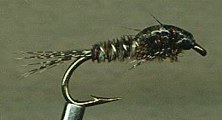Invicta Flies - Goode's Doubletake
Originated by Rob Knisely. This pattern has been a great go-getter since its creation in early summer, 2001. Upon its trial run, a 14" rainbow took it as it dead-drifted past. I was not quick enough on the hookset, but as the fly pulled away from it, the trout charged it and took it again, hence the name. The mottled coloration allows it to represent various nymphs, and the epoxy-coated flashback demands attention. Fish this fly dead drift. If no takes, pull it from the bottom with a raise of the rod tip, then strip in a few yards in short, quick strips. The largest fish have taken the fly just as the strips begin.
 |
 |
Hook: Mustad 3906B, #14-18
Thread: Danville's Prewaxed 6/0, black
Weight (optional): section of .015 lead wire (see note)
Tail: guinea hen fibers
Ribbing: fine silver wire
Abdomen: turkey primary fibers mixed with ringneck
pheasant tail fibers
Legs: guinea hen fibers
Wingcase: holographic tinsel or Flashabou, coated with
clear epoxy.
Thorax: peacock herl
Tying Instructions:
1.) Place hook in vise and secure thread, ending at hook bend.
2.) Tie in tail of ten natural guinea hen fibers, length one half to a full hook shank (use a length that is similar to most nymphs in your area).
3.) Tie in wire ribbing, portion to be wound extending beyond bend.
4.) Prepare abdomen: clip fibers from a mottled turkey wing quill, and a ringneck pheasant tail. Mix together and tie in at hook bend by the tips. (For size 14- use three turkey and four pheasant fibers, align butts, trim tips to even; for size 16- use three turkey and four pheasant fibers, align tips; for size 18- use two turkey and three pheasant fibers, align tips.)
5.) Bring thread forward to half way up hook shank.
6.) Wind abdomen fibers forward, manipulating them by twisting to form a mottled brown/gray/white abdomen. Tie off at thread and clip excess.
7.) Counter wrap the wire ribbing forward to thread. Tie off and clip.
8.) Tie in a section of holographic tinsel so the excess extends over abdomen toward bend of hook. (Size 14- use two stands of tinsel; size 16- use one strand tinsel; size 18- use holographic Flashabou.)
9.) Wind thread forward to just behind eye. Tie in twelve natural guinea hen fibers so they extend forward beyond eye, length 3/4 hook shank.
10.) Tie in four peacock herls by their tip. Wind thread back to rear of thorax. Twist herls together to form a rope and wind forward, then back again to thread. Tie off and clip excess. (For size 18 use three peacock herls)
11.) Wind thread through peacock herl forward to front of thorax. Pull tinsel forward over herl and tie down. Clip excess.
12.) Divide guinea fibers that are protruding over eye into two equal bundles. Pull those on the far side back and lash down with two thread wraps. Pull those on the near side back and lash down as well.
13.) Form a small head with the thread. Whip finish and cement the thread wraps.
14.) Place a drop of five-minute epoxy on the wingcase so it covers the entire flashback and just touches the abdomen in back and the thread head in front. Allow to dry.
Note: to add weight, spiral wrap a section of lead wire (.015) as long as the hook, in the area of the thorax; then, when forming the thorax, tie the herls in at the front of the thorax, wrap back, tie off, and wind thread through.